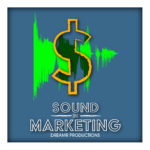I interviewed Jon Brennan and Sean Beeson of Sonic Signatures, a music creation agency specializing in sonic branding for brands and companies, in Episode 19 and 20 of the Sound In Marketing Podcast. We discussed some of what Sonic Signatures does and how important it is to think of your music as part of your branding; not as an afterthought. We’ll also delve into the world of user experience audio and what it means to the future of sound in marketing.
Jon, CCO of Sonic Signatures is a music composer and sound designer with 20 years of experience creating sound for iconic brands such as Tide, Applebees, AAA, Mentos, SW Airlines, and ADP. He has an MFA in Music Composition for the Screen from Columbia College Chicago and serves as an adjunct professor at Northern Kentucky University.
Sean, Audio Engineer at Sonic Signatures, is a composer and sound designer that has worked on hundreds of scores for games, ads, trailers, and podcasts, for clients like Google, Disney, McDonald’s, Taco Bell, State Farm, Wizards of the Coast, Neoglyphic, and Sony.
While at Google, he helped develop the sonic identity of Google’s Pixel phone (which we’ll bring up later in the interview), contributed sounds to the Google Max speaker, and Daydream’s internal VR and AR applications. He has contributed to three Emmy award winning projects, and has been nominated for multiple Game Audio Network Guild Awards.
Campaign Vs. Brand Minded Music Selection
The mission of Sonic Signatures as a company, is to create holistic audio campaigns that touch on all aspects of voice outreach; music, UX (user experience), and voice. A holistic audio campaign is crucial in this day and age. Why?
Let’s say you want to advertise on a voice first platform. If you were to only focus on the campaign at hand without consideration for if the sound is campaign or brand minded, your next campaign has a high probability of being “off brand”.
For further reference, I spoke about campaign versus brand focused sound selection in the previous episode Measuring the Value of Sound with Scott Simonelli.
Platform Consideration
Music branding aside, another factor that must be considered in the creative development process is which platform you will be targeting your campaign towards.
A TV campaign ad experience will be different than a podcast campaign ad experience.
You can’t recycle a TV ad and place it into a podcast ad without any alteration. The experience is different. The audience is different. It is a different medium and the delivery should be adjusted accordingly. That’s why Spotify and Pandora are working so hard with their advertising clients to re-create branded ads to fit the specific streaming platforms. They want these companies to succeed. They benefit from it too. So if we are recreating our ads (sometimes from scratch) based on the medium that the ad will be presented on, it’s imperative that we take a look at them from a branding guidelines perspective instead of as a one off campaign.
Music selection and placement can no longer be an afterthought.
Where Do We Go From Here?
Educating brands and agencies is number one on companies like Sonic Signatures agenda. They work hard to walk alongside brands to discover what is possible and share (in real time generally) new best practices that are developing and evolving everyday.
We are all, together, seeing audio rise up in this new era of marketing. It’s quite an experience to behold and an amazing time to experiment.
Podcast Advertising Example
Jon presented an example from a campaign that is currently in post production. It was for a car campaign for podcast advertising. As we discussed before, audience and medium need to be considered while developing the spots. Due to the fact that it was in a podcast and the user most likely had earbuds or headphones on, it needed to be subtle. No big and bombastic TV spots here. It was also being sent to a captive audience (the very nature of podcasts) focusing on an outdoor sense of adventure. The point was to strip it down to be as simple and subtle as possible.
Learning and Growing
Sonic Signatures, along with other sound agencies, are coming to companies and brands and laying out the audio “best practices” that they themselves are learning day by day. Most companies and brands want to learn and are excited for the opportunity to create something new. With this excitement, the sound agencies can then involve them in the creative process using mood boards and creative exploration. From this, a descriptive audio brief can be developed. One agency in particular was so pleased with Sonic Signatures work on their campaign that they blogged about it. Feedback and accolades like that are always appreciated. Not only that, but that SEO now sends out yet another example to the world about this new form of advertising; ideally sparking interest in more and more future clients for those of us in the sound marketing industries.
What Is UX Audio?
UX Audio, or user experience audio, is the design of audio that directly interfaces and responds to the users’ actions and provides them with functional feedback. It’s a way to even more fully create a cohesive experience from start to finish with the consumer.
A UX sound can be an alarm drawing special attention to something that the consumer needs to be aware of. It can also be a functionality like the sound of starting or turning off your car or your phone. It can be an error message when loading an application or an alert that someone has joined or left your conference call. It’s a chirp from your computer telling you you have a new email or a beep that the elevator doors are about to open.
Whatever specific UX audio sound is presenting itself; it presents itself in a non obtrusive auditory experience that tells you what’s next or what’s happening right now. It is there to assist your experience without overshadowing it.
Sean and the Pixel Phone UX Design
Sean shared some of his UX work on the Pixel phone. He used what was already existing to inspire new creative thought. From his research, he concluded that the design needed to be clean, minimal, and easily digested. Sean had to do a bit of surgical sculpting of very short sounds. People can perceive even the most subtle of differences. The subtlest tone alteration can change whether a sound is positive, neutral, heavy or light.
Both Sean and Jon’s examples were similar in the fact that both of these projects needed to be unencumbered and subtle; the opposite of in your face. Yet again proving that we are working in a different medium than visual.
The platform matters.
Stepping Stones
Choosing music and sound for your marketing campaigns takes time. Look back in the history of your company. What has been utilized in the past? Take that and build off of it.
There is no need to reinvent the wheel when there may already be spokes at your disposal.
You don’t want to completely reinvent. You want it to be new while still attributed to the old. This creates a sincere representation of the company. Music and marketing go hand in hand. You have to know the rules of marketing but also the rules of music.
It’s All Of Your Senses
Martin Lindstrom has an excellent book called Brand Sense: Sensory Secrets Behind the Stuff We Buy. If you really think about it, we’re only really investing and focusing on one sensory marketing approach; sight. There are four other senses that we’re sidelining.
So what are some ways to develop our sensory marketing further with minimal headache?
Implementing sound branding into your marketing strategy creates a way to start with a concept and a foundation that can then be built off of. It can be manipulated and progressed through multiple usages and over the entirety of a brand or company ethos. Once you can establish your audio DNA or “brand anthem”, you can then take that and create a story with it that changes depending on the story you want to tell. All the while staying on brand.
Some companies are all in with expanding their audio DNA, and some are coming back for more as time leads them.
And that’s ok.
What Does Sam Jackson Have To Do With It?
Jon, Sean and I talked briefly about how Samuel L. Jackson has now joined the voice marketing ranks as the first celebrity voice package option to Alexa.
Will people take on their own personal brand voice or ink deals with celebrities to voice it for them in the future?
Vocal narrative brand identity is here. It’s what people are tending towards. Anytime you have a voice of a brand speaking to you; that voice represents that brand.
Future Predictions and Thoughts
We’re now merging sonic branding with this UX audio and it’s being exploited within a lot of voice controlled applications and services where there is no visual stimulus to enhance the audio.
Audio is standing on its own two legs.
The sound marketing landscape is a massive and more complete experience in every sense of the word. Sound is and will be in anything and everything. Sean made a great comment about how custom sounds makes you feel like you bought “premium”. It “feels” like a quality experience.
The next evolution of sound innovation could be in the devices that are “listening”. What if there were ways for sonic branding to be heard by other smart devices and adopt or download a functionality based on what the consumer is consuming? What if it can “intelligently listen” to automatically configure itself to work with another device at hand?
Can hardware and software work together to utilize audio exclusively?


